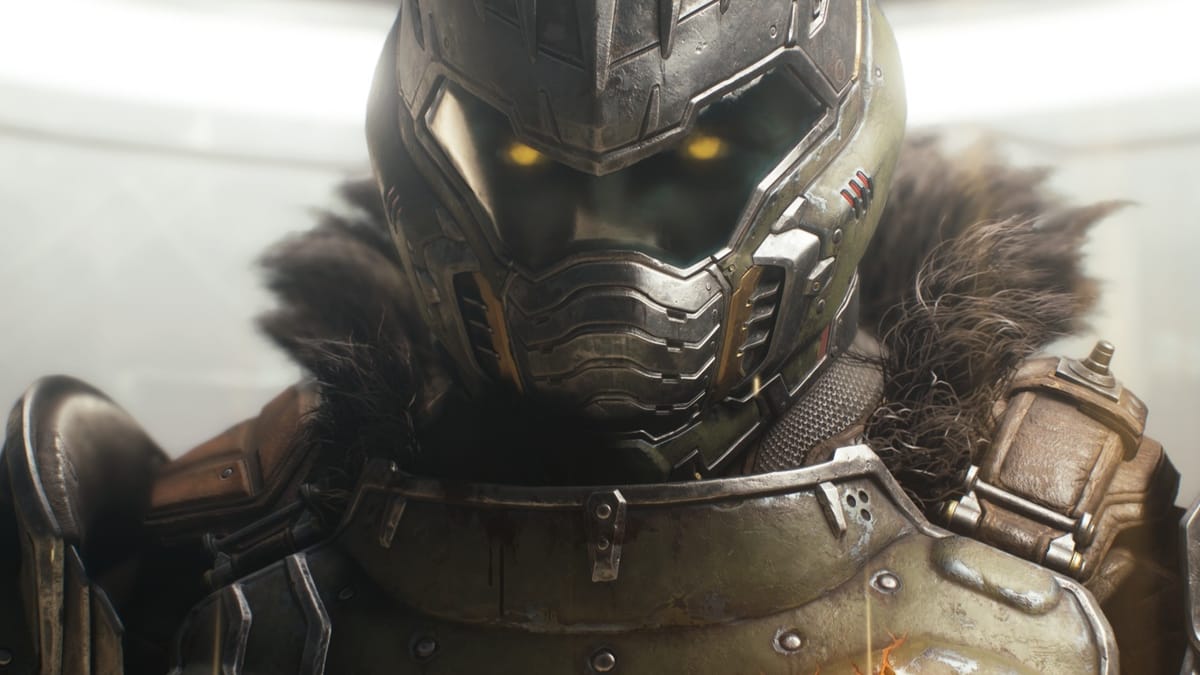
DOOM essentially birthed the first-person shooter genre in 1993, so much so that before the term was coined games like it were called DOOM clones. The genre slowly evolved over the years, eventually becoming focused on hiding behind cover and taking shots in between enemy volleys. DOOM 2016 brought the original’s fast paced and aggressive style back, and DOOM Eternal took that idea and made it much more acrobatic. Still, much of those games were about avoiding enemy fire while shooting back and getting in melee range for a healing glory kill. DOOM: The Dark Ages says: “what if you could run through bullets instead?” and makes combat even more aggressive and deadly. It has the highest highs of the modern trilogy, but also unfortunately finds itself saddled with the lowest lows.
I’ll be honest, I had no idea what was going on in DOOM: The Dark Ages story, which is a shame because a lot more emphasis is placed on it here with proper cutscenes and characters. Story isn’t what you come to DOOM for, and there are certainly a few moments where the Slayer gets to do something cool or a set piece becomes so gloriously stupid, but a lot of scenes are just characters I know nothing about expositing to you. This might be pretty cool if I was well versed in the lore, but I’m not and the in-game codex really didn’t help with that. Its best aspect, and I can’t believe I’m saying this, is that it attempts to make Doom Guy more human. He’s still the violent psychopath we all know and love, but he has moments of kindness and empathy in between slaughtering every demon in sight. Story still takes a backseat to gameplay, and at the very least it does move you from level to level fairly quickly.
Speed is the name of the game here, though the game is pretty long. It took me about 18 hours to reach the credits, though that’s playing on Nightmare difficulty and dying… a lot. You’re not locked into whatever difficulty you choose at the start, and can further customize the difficulty however you please at any time through a menu. You can adjust how much damage the Slayer takes, how much demons take, adjust the parry window, enemy aggressiveness, the speed of projectiles, the value of resources like ammo and health packs, and even the game speed as a whole. Nightmare starts you out at 250% damage to the player, for example, and due to things we’ll discuss in a bit I actually turned that down to 200% for the majority of the game, leaving everything else untouched.
DOOM: The Dark Ages is all about parrying, and it’s satisfying as hell. The Slayer comes equipped with a shield, which you can bring up to block at (almost) any time with right click or the left trigger. Simply holding it up will block bullets, though doing this will cause the shield to break for a time. Instead, you want to weave through the bullet hell towards green shots. Bringing up the shield just before a green attack hits you will parry it, stunning the attacker for a short time, sending their shot back at them, and/or activating an equipped Shield Rune. The parry window and distance is pretty generous too, so if you’re well versed in perfect parries or dodges from other games you’ll have absolutely no trouble pulling them off here.

The parry isn’t quite perfect though. A lot of times, I would parry something and it would go off just fine, but I would still take damage from the attack. This didn’t make avoid parries, but it’s a symptom of the game’s largest problem: everything needed to be much tighter for this style of combat to work.
Over the course of the game, I’d say at least half of my deaths had no perceivable cause, if not more. Enemies are constantly attacking you from all sides, so no doubt some of those deaths were from shots in the back. I can understand that, even if it doesn’t really feel “fair” and essentially requires you to turn up the FoV in the options menu, but what doesn’t feel fair is how massive the Slayer’s hitbox is. Doom Guy is a big guy, but I often found myself getting hit by shots that I had, at least from my perspective, dodged. I suspect this is also why parrying will sometimes still cause you to take damage as well. In addition to fighting the non stop onslaught of demons, you need to keep in mind the weird quirks of the game, which is a lot less fun.
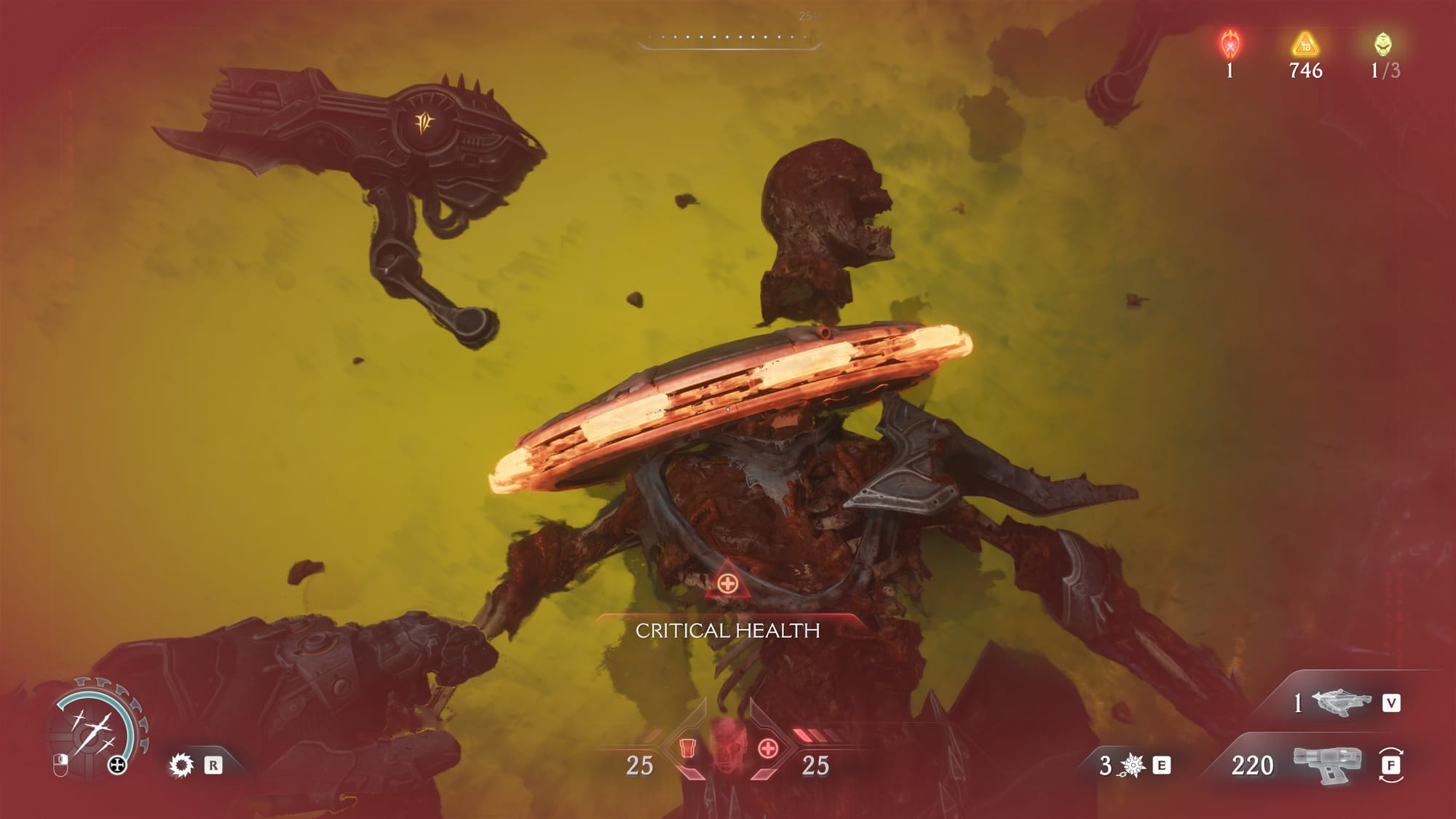
On the plus side, I do think these things could be tightened up in patches. In fact, right at the end of my playthrough a patch solved a huge problem I had. The Super Shotgun has a lengthy reload period between shots, but previously you couldn’t raise the shield while this animation was playing. That one thing made that particular gun essentially less than worthless despite its high damage output and ability to quickly break armor; you’re parrying that often. While not the main focus of the patch, it did fix this issue and I happily used the Super Shotgun for the final two levels. Little things like this are huge in a game that wants to be precise like DOOM: The Dark Ages.
This leaves pre-launch reviews like this one in a tough spot. The moment the game releases a day one patch could address all of my issues with the game, but it’s not like I can change my review or the score after the fact. Besides, I have to review the game they gave me in its current context, disregarding outside factors and evaluating the work provided.
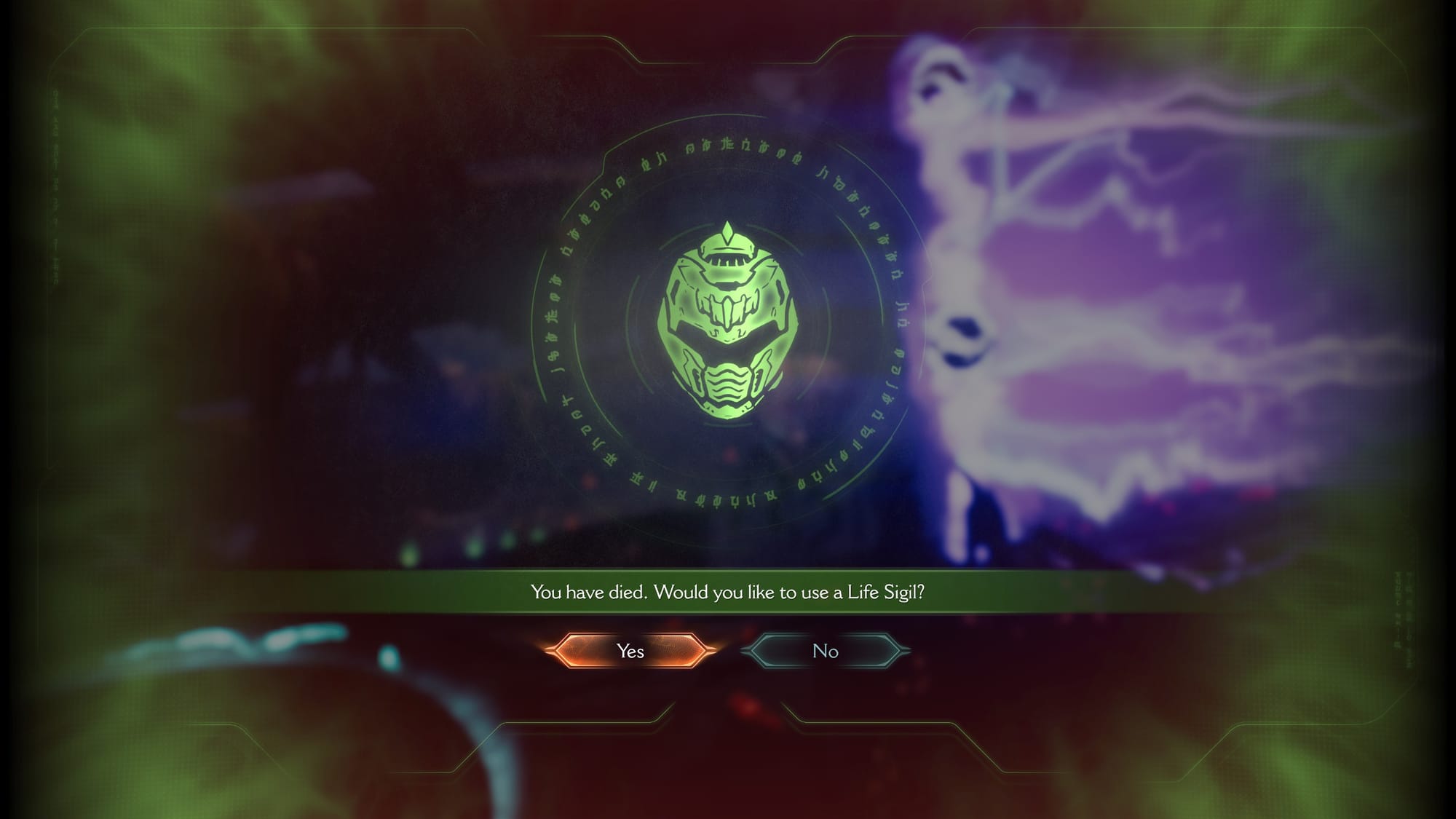
Aside from those issues, The Dark Ages is a blast. Sometimes literally, with certain weapons. The game provides a great arsenal of twelve weapons you unlock over the course of the game. There are six weapon types, with each having two guns associated with them (except for one, which is weird). You can swap between them whenever you wish, but guns in the same class will share ammo. Each gun has its use, though it does feel like there’s a lot of overlap between them. For example, the Shredder and Accelerator are both rapid fire weapons, but they do set themselves apart through the upgrade system.
There are tons of secrets hidden in each level, including three types of currency used for increasingly powerful upgrades. While also a rapid fire weapon, the Ravager can be upgraded to cause demons to drop health pickups on hit. Many guns might feel similar, but you really need to keep in mind their upgrades to make best use of them, especially since sometimes you have to choose between two upgrades that may offer very distinct paths, like if shots ricoche off of an enemy when they’re stunned with the shield or if they detonate to deal more damage.
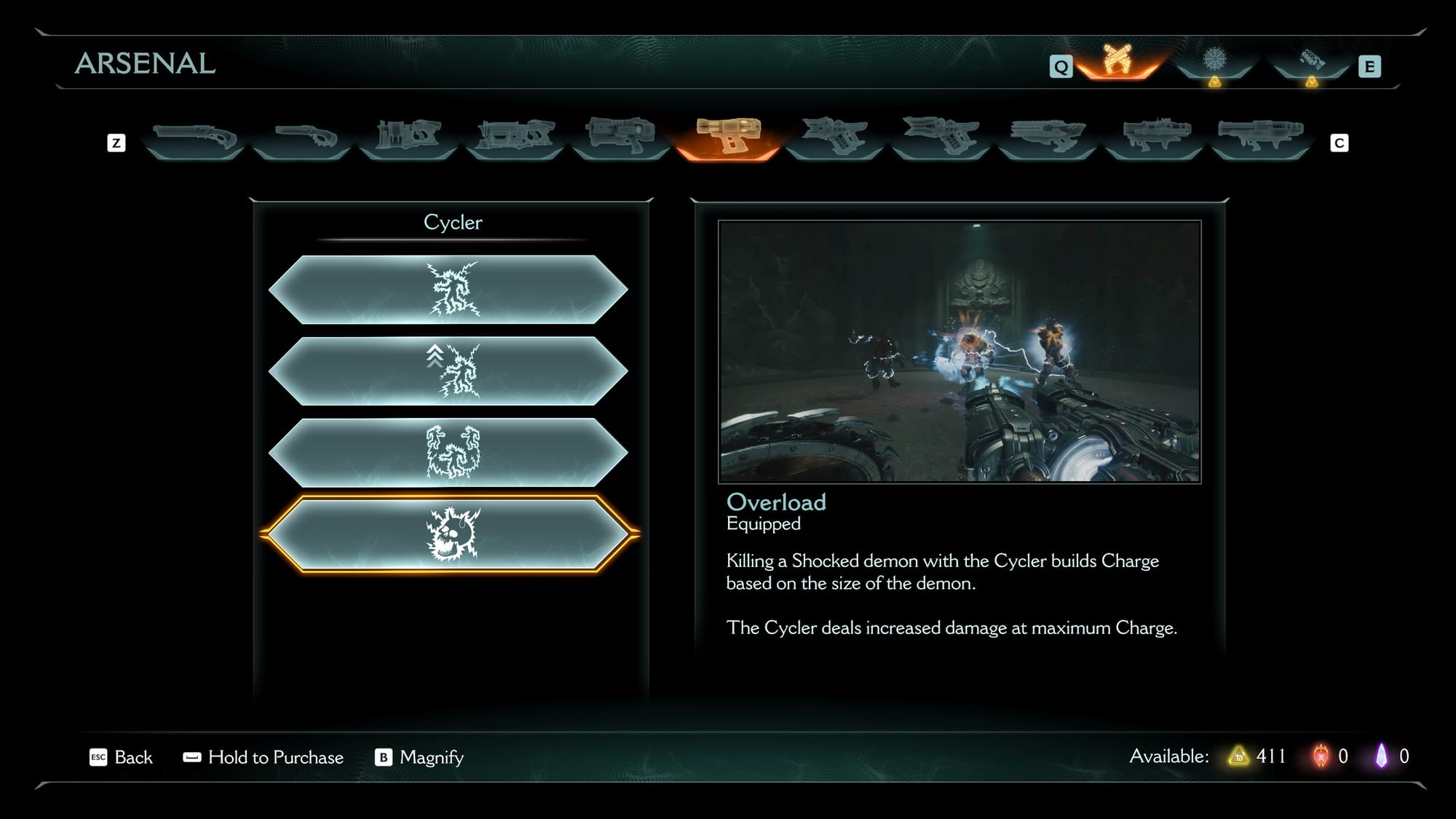
In the end though, you can really just pick your favorite few weapons and use them for the majority of the game. As I said earlier, I ignored the Super Shotgun for 90% of the game and was just fine. I’d recommend you at least keep an open mind, as something like the Chain Shot can fill a great niche of dealing heavy damage to enemies you need to parry constantly. The Chain Shot has an upgrade that fully charges it after a parry, so you can stand there just parrying attacks while dealing tons of damage very quickly. You can find uses for every weapon, but it’s not required.
This lets the game focus much more on player expression rather than perfecting every encounter, like DOOM Eternal. A lot of this is due to ammo being far more plentiful. Your melee attack will cause any demon hit to drop tons of ammo packs, which can refill any weapon. So if you ever find yourself low on ammo, just go punch a demon in the face and you’ll be back to full in no time. You don’t just have to punch, however, as there are now three melee options: fists, a flail, and a mace. Fists recharge the fastest and are easy to combo with if you really need tons of ammo. The flail recharges slower, but can be upgraded to deal more damage to armored foes while also dropping armor for the Slayer and hitting nearby enemies. Finally, the mace has a single charge, but hits like a truck, has splash damage, and will replenish all of your gun ammo instantly. I stuck with the flail for most of the game, since it felt like it struck a nice balance between damage and recharge speed. I also liked being able to combo enemies, as getting right in their faces and seeing them literally fall apart as you hit them is incredibly satisfying.
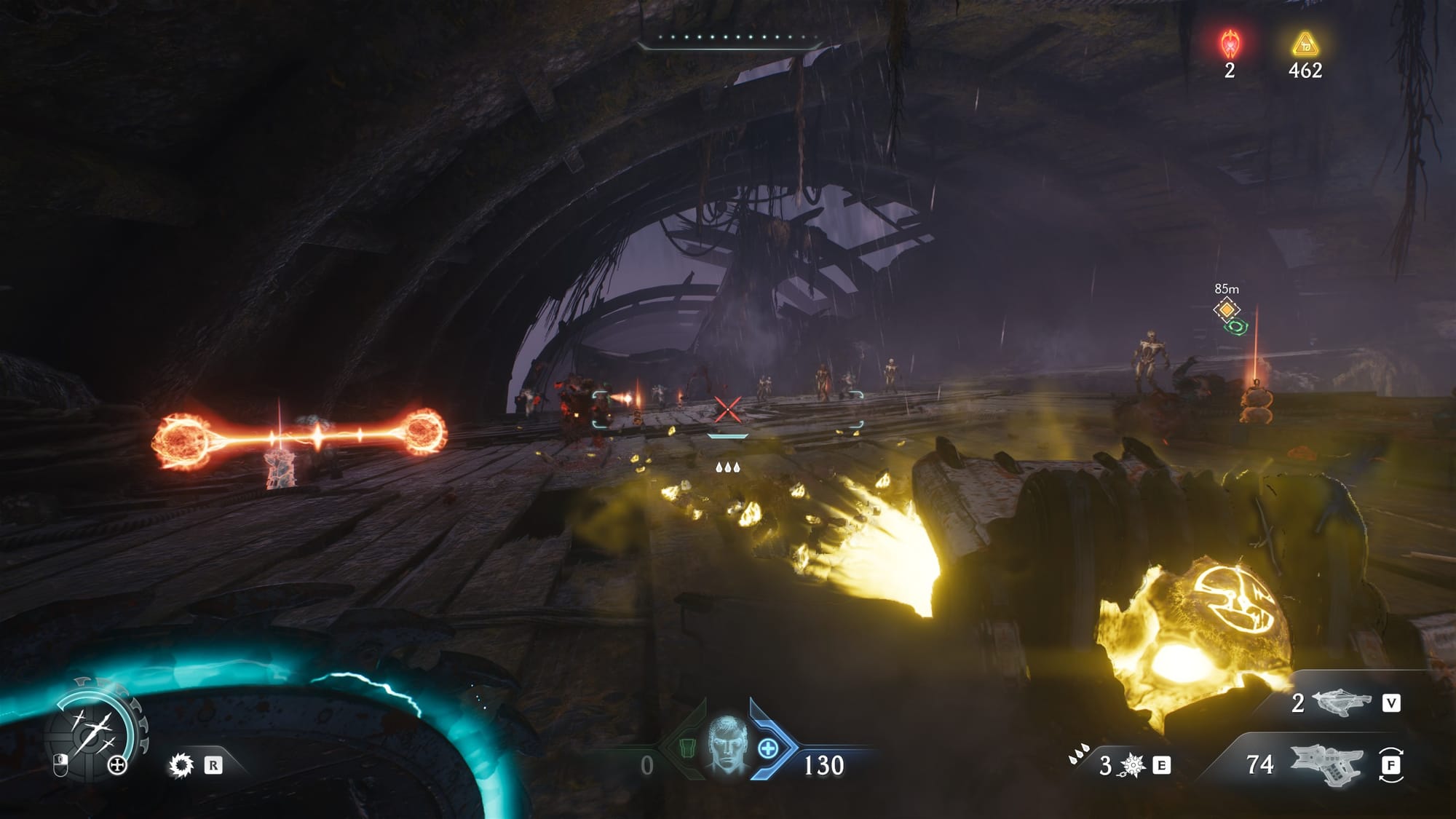
Put all this together with your super fast movement speed and you essentially feel like a sports car with heavy ordinance attached. Getting hit will absolutely devastate you on any difficulty, though obviously much more on higher levels, but you can maneuver about the battlefield quickly and retaliate in kind. If all else fails, you can throw your shield into a demon to stun them, then run up and beat them to death. Being this fast is a necessity, as some of these levels are massive. I generally prefer the more linear stages, as more open ones start to feel samey after a while. Each asks you to complete a certain number of encounters across the area, though there are also optional ones and secrets to find.
Secret hunting makes the game a whole lot more fun, but also slows things down considerably in these open zones. You might find the blue key in the east part of the map, then have to run all the way back west to open a secret door and grab the gold inside. Just going from objective to objective will have you feeling severely underpowered, since you’ll rarely find gold for upgrading your weapons and other skills. It can feel like a bit of a chore to find everything, especially with the difficulty of navigation. The auto map is great, and will even show you where every secret is in a level, but you can’t place your own markers or anything on it, forcing you to open it constantly to confirm where you’re going. The game has a compass, but it’s basically useless and only points out Sentinel Shrines where you can purchase upgrades. It doesn’t even show cardinal directions, so I’m really not sure why it’s here.
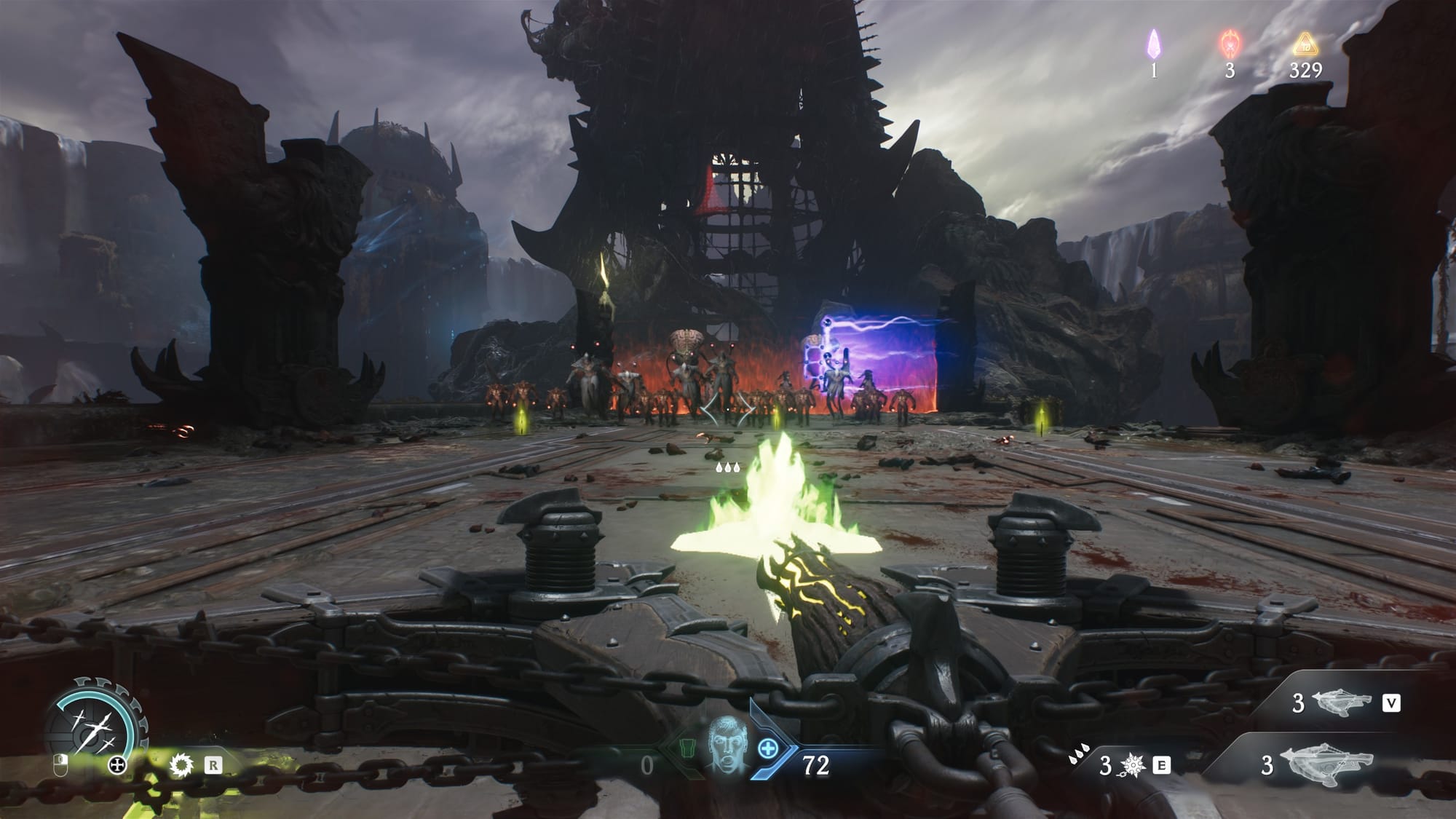
Linear stages don’t exactly have this problem, and often make it much easier to backtrack if you need to through some clever looping design. The game will also let you know when proceeding with the main objective will lock you out of backtracking, at least most of the time. An objective marker with a door will tell you that things will proceed if you pass it, though sometimes these will only show up after you’ve already locked yourself out of going back. It’s not perfect, but it’s pretty handy.
While most of the game is spent as the Slayer on foot, there are certain sections where you’ll be piloting a giant mech called an Atlan or riding your trusty cyber dragon. As cool as they are visually and conceptually, I found these to be mostly underwhelming. The Atlan feels incredibly limited in combat, simply punching enemies to build up a meter which, when full, allows you to perform an extra strong attack. In lieu of parries, you now have a perfect dodge which powers up your attacks or your weapon in the two or three times the game gives you one, but that’s about it. It just feels like it's missing something and leaning too heavily on the spectacle.

The same goes for the dragon, though it is generally more interesting. You might think you’d be flying around at high speeds, chasing down demons and taking them out with the mounted turret and the dragon’s claws and you’d be right… for the few optional demons. Most dragon levels are huge open areas, and you can find a few demon ships throughout that you need to follow and shoot down for some gold. Most of what you do with the dragon, however, is far less interesting.
Essentially, you hold down right click to target an enemy, which places you in a specific location to hover. You then hold left click to shoot, and move with WASD then press space to dodge. Moving really only determines the direction you dodge rather than strafing around the enemy, and you do need to dodge in specific directions to avoid attacks here. Dodging a green shot will slow your turret down, but cause it to deal special damage that pierces enemy shields, meaning the perfect dodge is required to defeat most foes here. It’s interesting at first, but never gets more complex than that. Unlike the Atlan, there’s a much more interesting gameplay style right there for the dragon, but it is entirely optional and rarely appears.
From a technical perspective, DOOM: The Dark Ages is a triumph. Running it on my 2080 Super-powered laptop, I was able to achieve triple digit framerates at 1440p with DLSS enabled. While it’s not a surprise to see 200+ fps at 4K / Ultra Nightmare on an RTX 5080, it’s amazing to see it on a portable platform that is three generations old. Looking at the requirements, it’s easy to get discouraged that you might not be able to rip and tear until it’s done, but I’m happy to say that’s not an issue for the idTech8-powered game.
Visually, this game is a feast. That’s no surprise as the previous games were as well. It’s dark, gritty, and blood-soaked just as much as it’s neon-flooded with giant red glowing pentagrams, purple keys, and bright green armor chunks. Rushing forward to shield bash your enemies into a warm paste gives off some excellent blur effects punctuated with a satisfying thud and resultant gory goodness. When you collect toys (glad to see these return) you can inspect them as in previous games, but a closer look causes them to transform into their in-game awfulness. It’s great to be able to get a better look at some of the grisly beasts you’ve been cutting to bits without having to worry about gunning them down in a blur.

The gorgeous visuals extend beautifully to the gritty audio. The soundtrack shreds, making that upgrade purchase to get a digital copy of it worthwhile. Enemies speak with as much gravitas as laughably overserious tones, telling the story of The Slayer and his return to fight the denizens of Hell itself. If you’ve got the sound gear to showcase it, or you’re using headphones to experience it more closely, it’s a pulse-pounding good time. Kudos to the audio and visual crews for their hard work.
DOOM: The Dark Ages
Great
DOOM: The Dark Ages throws everything and the kitchen sink at the wall, and a lot of it sticks. However, just enough of it doesn’t stick to drag things as a whole down a few pegs. Gunplay and parrying feels great, as does weaving through the bullet hell-esque attacks, but suddenly dying for no perceivable reason does not. Still, it’s a game worth your time for those highs, even if you have to get through the lows to reach them.
Pros
- Parrying feels incredible
- Well-optimized graphical and audio feast for the soul
- Tons of weapons to use and upgrade
- Has some gloriously stupid moments
- Great difficulty and accessibility options
Cons
- Self-serious lore can be obtuse
- Some levels feel too large for their own good
- Tons of unfair deaths
- Atlan and Dragon are mostly boring
- Parrying can still cause you to get hit
This review is based on an early PC copy provided by the publisher. DOOM: The Dark Ages comes out on May 15, 2025.
